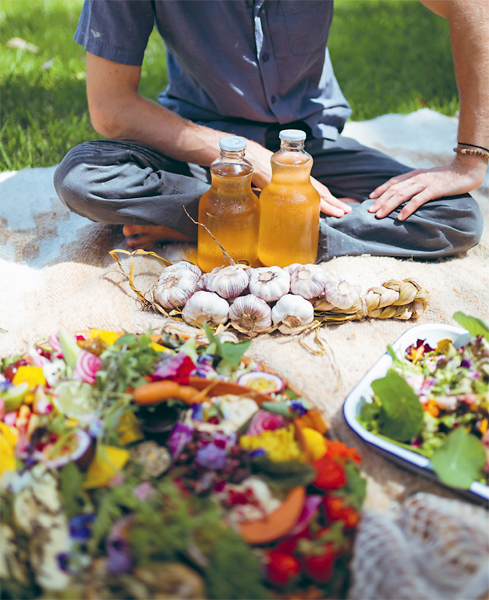
Picking and Harvesting.
Gathering your ripe fruits and vegies is a triumphant moment, especially for long-awaited goodies such as your first-time bunch of juicy grapes or fat butternut pumpkin. But how do you harvest those fruits, vegies or leaves when you need them? It’s generally best to cut each fruit or vegie from the stem using a sharp knife, scissors or secateurs. Try not to pluck a fruit or tear a vegetable off the stem with your hands, as this usually damages the plant. In addition, the produce you’ve picked will store better with some of the stem attached. Some plants, such as lemongrass and rhubarb, naturally break off quite easily when plucked, so you won’t damage the plant in this instance.

HERBS
These beauties are best picked and used fresh for fragrance and flavour – that’s the benefit of having them on hand. If you need to store softer herbs, such as parsley, coriander (cilantro), dill, basil or mint, I find that wrapping them in a damp paper towel or cloth and placing them in the fridge keeps them sprightly. Bunches or sprigs of hardy perennial herbs, such as rosemary, thyme, bay leaf, oregano and sage, do well in a vase of water on the kitchen bench for easy picking. Fresh herbs contain aromatic oils, and their scent breezes through the home if they are left on display.
Dried herbs have their uses, too. I often have a big bunch of dried thyme in a wooden bowl in the kitchen for months. It is so handy to have strongly flavoured homegrown thyme at the ready.
Hardy perennial herbs grow thicker when they are used often. The continual cutting of the stem tips triggers more lateral leaf growth, so they naturally grow wider and bushier. It’s also lovely to let herbs flower, as the blooms attract beneficial insects and bees to the garden that help keep the balance. You can also use the flowers from rosemary, sage, thyme, English lavender, nasturtium, borage and bergamot in your recipes.
LEAFY GREENS
If you’re harvesting leafy greens, such as kale, English spinach, silverbeet (Swiss chard), rocket (arugula) or mizuna, just cut the outer leaves off close to the main stem without cutting through or removing the inner leaves. For quick growers, such as cos (romaine) lettuce and bok choy, you should harvest the whole head at once by cutting off at ground level.
VEGETABLES AND FRUITS
Learn to know when each type of vegetable or fruit is ripe – check its colour and smell, see whether it feels soft to the touch and give it a taste test. Is it the right time in the season for the crop to ripen? If the plant has to come out early to make way for next season’s soil prep, the crop might still ripen inside the house. You could even have a go at drying the crop for later use.
If you know that a big crop is on the way – congratulations! You will soon be able to provide yourself with wholesome homegrown food, and it’s a skill you can use forever. Plan a recipe, and check if you need anything else so you’re good to go. After we had picked our 300th jalapeño from our garden, we gave about 30 to our neighbour, Karen, and she returned with a jar of the best hot sauce we have ever tasted! Sharing a recipe or a big harvest always connects you with people and nature, just as food has always done in every culture.
OUR SUNDAY CO-OP
How long has it been since you created something with your hands? Or said to yourself, ‘One day I’m going to make this’? Well, a bunch of our friends and us decided that we would get together for a homemade meal once a month so we could talk, eat and trade our latest handmade creations. You could make, grow or cook anything and bring it in bulk to swap for other goodies. I could take 12 jars of honey and bring home 12 uniquely made items, such as handmade candles, garden pots, condiments, ginger beer, kombucha, handmade oils, bath soaps/salts, seedlings or sourdough. We had so much fun doing the Sunday Co-op with our mates.
| – | We found that making one thing in bulk is far cheaper than buying or making 12 individual items. |
| – | We enjoyed learning to make something new each month, then giving a little spiel about the process to our friends. |
| – | It kept our creative brain firing, as we had something to work on over the month and we anticipated what would be brought along next time (as your latest creation was kept secret until you presented it on the day). |
| – | It got us back in touch with the art of sharing and trading. |
| – | Everyone ate, learned and had fun, and we all walked away with a crate full of goodies – it’s like having Christmas once a month. |
If you have surplus food from your garden and recipes at your fingertips, you could initiate a Sunday Co-op with your friends. You never know what hidden talents are waiting to blossom.
